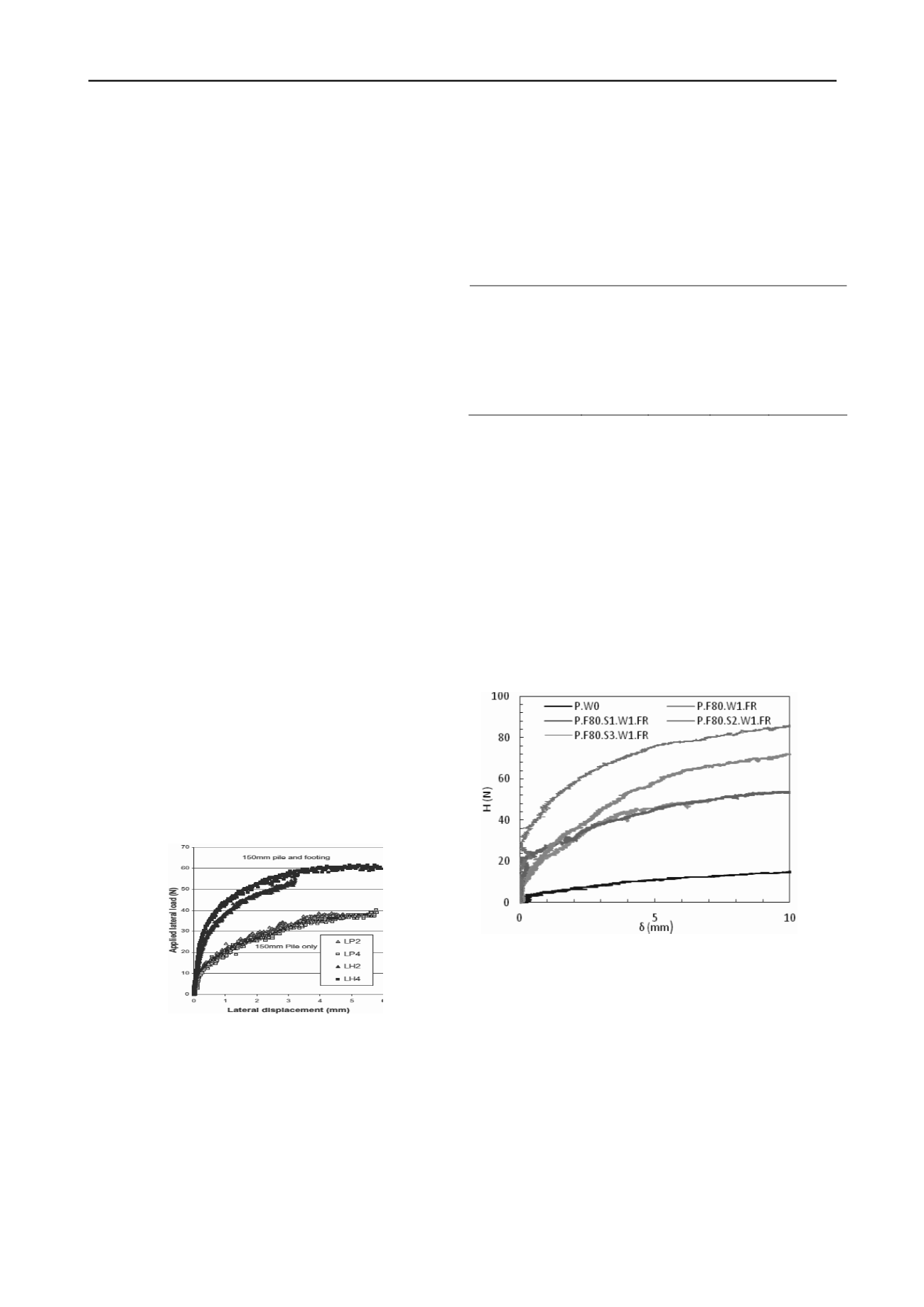
2308
Proceedings of the 18
th
International Conference on Soil Mechanics and Geotechnical Engineering, Paris 2013
comprises of a circular footing attached to the monopile at the
mudline. A 2-D analogy of this system is that of a retaining wall
with a stabilising base (Powrie and Daly, 2007). The role of the
footing is to provide a degree of rotational restraint at the pile
head, leading to an improvement in the lateral resistance of the
pile. It has also been shown that the use of a relatively thick pile
cap leads to an increase in the lateral resistance through the
development of passive soil wedges (Mokwa, 1999), in a
similar way to the behaviour of skirted foundations (Bransby
and Randolph, 1998).
Analysis of the hybrid system would involve both lateral pile
analysis and bearing capacity analysis. The lateral response of
piles is well reported in the literature and various methods of
analysis have been proposed by numerous researchers, such as
Matlock and Reese (1960), Broms (1954), Poulos (1971), Reese
et al.
(1974), Randolph (1981), Duncan
et al
(1994) and Zhang
et al.
(2005). Where the plate diameter is relatively small, the
system is similar to a single capped pile, for which methods
have been developed for analysing the influence of the pile and
pile cap under axial loading (Poulos and Randolph, 1983), and
the effect of the pile cap on the lateral performance of single
piles has also been investigated by others (Kim
et al.,
1979),
(Mokwa and Duncan, 2001: 2003), (Maharaj, 2003).
The bearing capacity problem has also been investigated
under different loading conditions relevant to offshore
foundations, see for example references Houlsby and Puzrin
(1999), and Gourvenec and Randolph (2003).
2. EXPERIMENTAL INVESTIGATIONS
The potential performance of the hybrid system was
investigated in single gravity studies (Stone
et al.
(2007)) and is
illustrated in Figure 2. These studies suggested that the
additional rotation restraint provided by the footing can result in
a stiffer lateral response of the pile and greater ultimate lateral
load. The degree of restraint at the pile head was dependent on
the size of the footing, the initial contact between the soil and
the footing and the stiffness of the soil beneath the footing.
Observations of heaved and displaced soil in front of the edge
of the footing also suggested that a degree of passive soil
resistance is likely to be generated under the lateral movement
and rotation of the footing.
Figure 2. Lateral load response of the hybrid system (after Stone
et al.
2007).
Arshi (2011), and Arshi and Stone (2012) reported the
results of a comprehensive series of single gravity testes carried
out on the foundation system where the elements affecting the
overall performance of the foundation system was investigated
in depth. It was reported that the size for the footing has a direct
effect on the overall lateral load bearing capacity of the
foundation system. Furthermore it was reported that the ratio
between the vertical and horizontal load has a significant effect
on the lateral performance of the foundation system where
larger vertical loads tend to improve the lateral load bearing
capacity of the hybrid system. The connection between the
footing and the pile was also investigated where it was
suggested that the hybrid foundation system tends to be more
effective if vertical movements are allowed at the pile-footing
connection. This movement allows the footing to act
independently from the pile where the positive contact between
the footing and the soil underneath is solely controlled by the
vertical load acting on the footing.
Table 1. Notations for skirted hybrid foundations system
ID
Footing
size
(mm)
Skirt
length
(mm)
Dead
load
(N)
Footing to
pile
connection
P.W0
-
-
0
-
P.F80.W1.FR 80
100
Slipping
P.F80.S1.W1.FR 80
100
Slipping
P.F80.S2.W1.FR 80
100
Slipping
P.F80.S3.W1.FR 80
100
Slipping
More recent single gravity tests are presented in Figure 3
where skirts with different lengths have been added to the
footing. The tests were conducted in sand and the results
indicate that the presence of the skirts has a relatively
significant contribution on the lateral load capacity of the
system. The results show that adding the skirts to the footing
and increasing the skirt length tends to increase the lateral load
bearing capacity of the foundation system by about 50% in
comparison to a non-skirted hybrid system. It is also apparent
that footings with very short skirts do not tend to show any
‘apparent’ additional advantage to that without the skirt. This
could be due to the fact that the stresses around the skirt induced
by the soil are very small at 1g. Further studies in the centrifuge
are in the taking place to investigate the effect of the skirts and
the results will be reported soon.
Figure 3. Load vs. deflection plot for the hybrid system with skirts.
Stone et al (2011) reported the results of a series of
centrifuge tests in sand. The results of the combined vertical
and lateral loading tests are best represented through plots of
lateral load versus lateral displacement. Figure 4 shows a plot of
the lateral load versus lateral displacement for the monopile-
footing (HL 1) and single pile (PL 1) with a vertical load of
600N at 50 g. It is apparent from this plot that the initial lateral
stiffness of the monopile-footing and pile are similar for the first
1–1.5mm of lateral displacement. However the monopile-
footing continues to exhibit a stiffer response than the single
pile as the lateral displacement increases. Further analyses of
these data provided information on the redistribution of bending
moment in the pile due to the plate.


